5 Must Haves for a Dachshund Recovering From An IVDD Back Injury
My Dachshund Gretel suffered a back injury and was diagnosed with Intervertebral Disk Disease (IVDD) in 2016.
Many friends and members of our Dachshund club have shared their experiences with IVDD and recovery with us over the years.
Here are 5 things I found essential to get through a back injury and the recovery period.
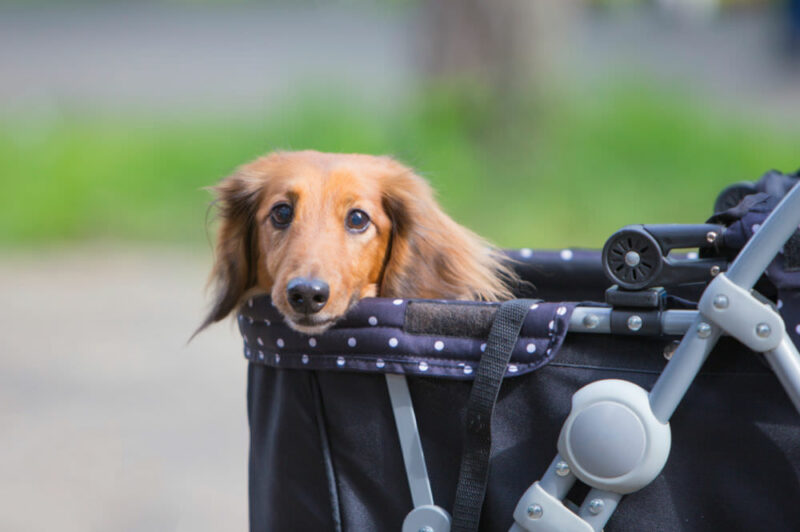
Disclosure: Some of the links in this article are affiliate links (Amazon Associate or other programs we participate in). As an affiliate, I earn a small commission from qualifying purchases.
1) Recovery Suite
This is the #1 thing that you’ll need to help your dog recover from an IVVD-caused back injury.
There will be a prolonged period of time – usually 5-10 weeks – following an injury or surgery where you will need to keep your Dachshund as immobile as possible.
The way you will do this is through confining their movement to a small space, carrying them in and out of the house to go potty, feeding them where they lay or carrying them to their food dish, etc.
The small, confined space used to restricts your Dachshund’s movement is called a “recovery suite”. It’s often referred to as “crate rest” because most people use a dog crate for this.
Click here for my tips on surviving crate rest with your Dachshund
If your Dachshund has not been trained to be comfortable in a dog crate, and/or has separation anxiety, this period of confinement could be very stressful for your Dachshund…. and you!
With every option below, it’s absolutely crucial that your Dachshund can’t stand up on their hind end and jump inside of the enclosure.
Options for an IVDD recovery suite
There are several options for a recovery suite but you need to have one.
It’s paramount to your Dachshund’s healing and recovery.
Keep in mind, the larger the space in your Dachshund’s recovery suite, the easier it is for your Dachshund to move around too much, or jump up on the sides, and not heal well or reinjure themselves.
But sometimes a compromise is necessary to maintain your Dachshund’s, and your, sanity.
If you feel too bad confining your Dachshund to a small space, if it’s too stressful for them, or if they drive you nuts with whining and barking, you won’t stick with the full crate rest period recommended.
My veterinarian told me that’s one of the primary reasons that a Dachshund may continue to have back issues throughout their lifetime – the crate rest wasn’t completed so the dog never fully healed – so please find what works for you and stick with it.
A Dog Crate or Kennel
Use a small dog crate just big enough for your Dachshund to stand up and turn around.
Put at enough bedding or blankets in there for comfort and to further restrict the amount of space your Dachshund has to move around.
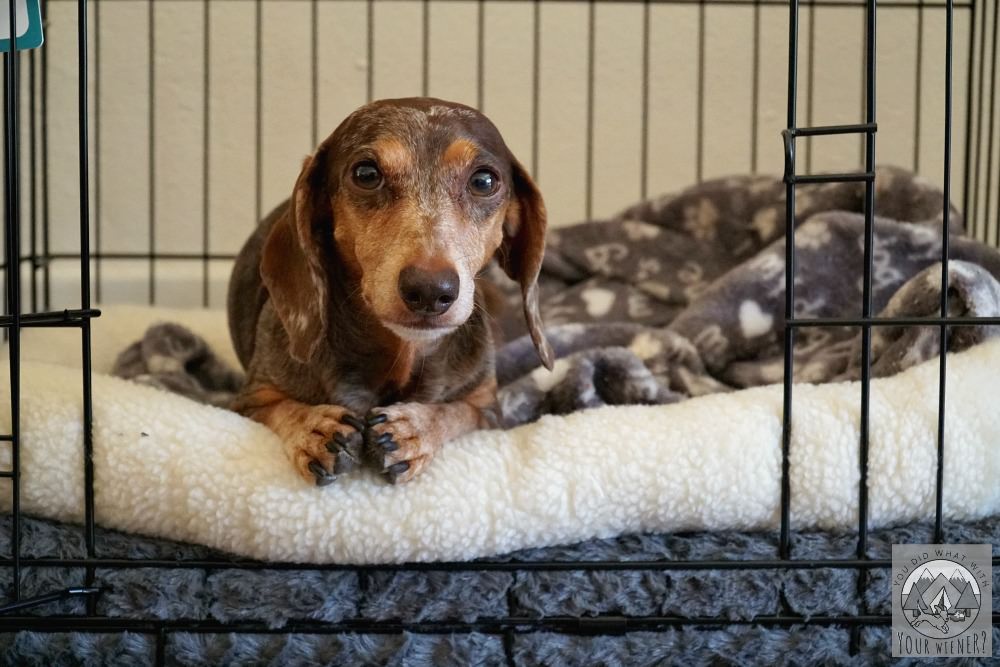
The advantage of using a crate is it’s the smallest of all the options, which does a better job at keeping your pup from moving around and also takes up less space in your house.
As a bonus, this is something a lot of dog owners already have on hand.
A Portable Dog Playpen
The advantage of using a dog playpen over a dog crate is that your Dachshund won’t feel so closed in due to the larger space and the fact that there is no top (although this pen comes with a cover that’s handy if you want to bring the pen outside so your pup can get some fresh air).
But this larger space with no top comes at a cost. The larger space means it would be easier for your Dachshund to move around too much, or jump up on the sides, and not heal well or reinjure themselves.
Filling the entire floor with blankets and/or a bed can help your Dachshund settle and not move around as much.
The bonus with this option though is you can use this portable, collapsible, covered playpen in the future other things like camping, picnics, or staying at friend’s houses.
A Dog Stroller
A dog stroller is essentially a small dog crate on wheels. This means you can wheel your Dachshund around the house with you as you go from room-to-room.
This is a good option for Dachshunds who have separation anxiety and can’t bear to let you out of their sight.
Make sure you get a dog stroller that has a lid you can close it and one that is stable enough it’s unlikely to tip over.
We have this all-terrain jogger stroller because of the air-filled wheels and shocks make for a more comfortable ride and the rotating front wheel makes it super easy to maneuver.
If you need a more affordable option, take a look at this urban dog stroller. It will be fine if you’re just using it around the house or on pavement.
A High-sided Wagon
Some people place their Dachshund’s crate on a wagon so they can pull their dog around the house with them.
This is another good option if your Dachshund gets stressed and anxious when they are separated from you.
You can also place your Dachshund directly into the wagon and make them a snug nest with blankets.
This is probably the most risky option for a recovery suite though in regard to your dog’s ability to jump out.
For this reason, a wagon with high sides, like this collapsible, folding utility wagon or this red metal wagon with side rails, are good options.
2) Something to Help Keep Your Dog Calm
During the first week of crate rest, the prescribed pain and steroid medication will help keep your Dachshund calm and settled.
But after that, your pup may start to get restless.
During My Dachshund Gretel’s 10 weeks of crate rest, I tried a few different natural remedies but found that Vetriscience Composure, and Hemp CBD for dogs, were the natural calming remedies that worked best for us.
I will note, for both products, I had to double the recommended dose to achieve a sedative effect.
Some people have tried calming herbal sprays, phermone diffusers, or other “relaxing” herbal remedies with some success. Those didn’t do anything for Gretel.
If natural remedies don’t work, I highly suggest asking your vet for a medication that will keep your dog calm and still.
I don’t recommend “drugging” a dog unnecessarily but crate rest is definitely a time when one must do everything they can to make sure their dog stays still enough to recover.
3) A Do Not Disturb Sign
I don’t know a single Dachshund that won’t jump up and start barking when someone knocks on the door.
You’ll want to minimize that happening as much as possible while your Dachshund is recovering from their back injury in their suite.
I purchased this Do Not Knock or Ring Doorbell, Dog Will Bark sign.
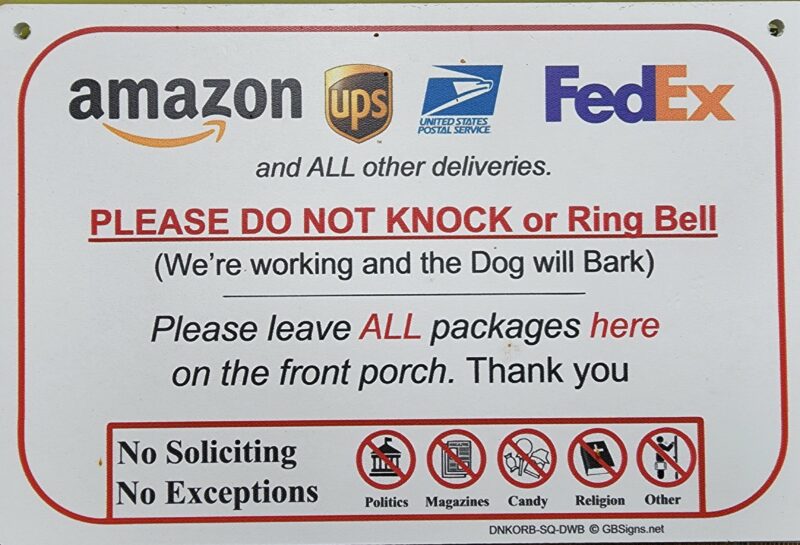
Not only did it it stop FedEx and mail carriers from knocking when they dropped a package off on our porch, it deterred solicitors and other unexpected visitors too.
It made our house so much more peaceful, it’s been on our door for the last 5 years!
In addition to the sign, we ask friends, family, and expected visitors to text when they arrive so I can open the door for them before they knock.
4) Dog Stroller
I mentioned dog strollers in the recovery suite section above but I used a stroller in addition to the recovery suite for my Dachshund Gretel.
I used the stroller for when Gretel wasn’t resting in her dog crate.
It was a game-changer for both of our mental and physical wellbeing during the IVDD recovery process.
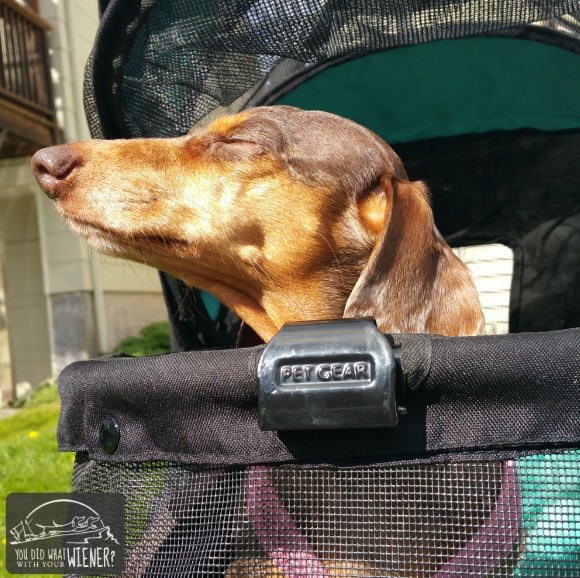
After about 2 weeks I got clearance from Gretel’s rehab vet to take her out in the stroller for “walks”. She was so happy to be able to sniff the fresh air.
I had a second Dachshund who needed regular walks and I felt extremely guilty leaving Gretel at home. I didn’t have to once I could take her in the stroller.
I also used the stroller when we visited friends and family. It acted as a mobile recovery suite so I could bring her traveling with me like normal while keeping her safe.
I chose an all-terrain jogger stroller because our walks were often off pavement. It has air-filled wheels for all-terrain traction, shocks to soften any bumps, and a rotating front wheel that makes it super easy to maneuver (but it can be locked in place if needed).
Dog strollers aren’t cheap though. Especially the one we have.
If you need a more affordable option, take a look at this urban dog stroller. It will be fine if you’re just using it around the house or on pavement.
5) Light Therapy Device or Cold Laser
Part of Gretel’s treatment protocol included a series of cold laser treatments and I think it was one of the keys to her complete recovery (from that injury).
But the treatments at the vet, especially if I continued them regularly throughout her lifetime to help manage flare ups and inflammation, would be expensive.
It’s also inconvenient for me to take her to a veterinarian 3-5 times a month for treatments.
That led me to buy a cold laser for use at home.
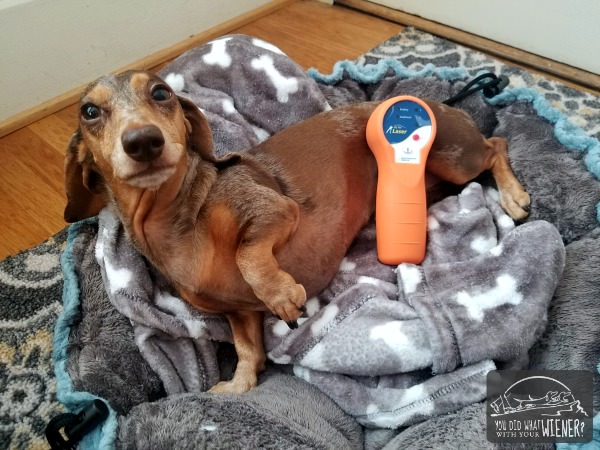
I purchased the My Pet Laser by Multi Radiance Medical.
After all my research, it appeared to be the closest thing to my veterinarian’s laser I could get.
Because I bought it through Dr. Youkey DVM, I also receive ongoing support from her.
Note: If you want to purchase the My Pet Laser, contact Dr. Youkey at Laserriffic.com and use the code LONGBACKS to get $125 off of the retail price of the laser.
I will be frank though: You pay for quality and this laser is not cheap.
If you need something that is less expensive, try the LumaSoothe Pet Light Therapy Unit.
Although the Lumasoothe Light Therapy device is more affordable, it also requires at least three times the treatment time to potentially achieve a similar result as with the My Pet Laser (5 minutes vs 15 per treatment).
Although it’s not a cold laser or light therapy device, another therapeutic option is the Assisi Loop®.
The Assisi Loop is a FDA-cleared Non-Pharmaceutical Anti-Inflammatory Device (NPAID®) that works of a principle similar to acupuncture.
The Assisi Loop uses a targeted, pulsing electromagnetic field to create a reaction that reduces inflammation and pain and promotes healing.
Final Thoughts
The items above were what I found essential during Gretel’s conservative recovery period and keeping us both happy and sane.
If you can only get one of the things on the list above, the most important thing is the recovery suite.
The rest can help but nothing will help but nothing is more important than keeping your Dachshund largely immobile while the spinal disk is healing.
But after recover, you will need some additional things to help keep your Dachshund injury free.
One example is a system to prevent your Dachshund from jumping off off furniture.
You may want to update your Dachshund’s supplement list too. There are several supplements that can help with joint care and help keep inflammation in check.
For more information, check out my IVDD resource page.

About the Author
Hi, I’m Jessica. I’ve been studying the Dachshund breed since 2007, owned 3 of my own, and shared in the lives of thousands of others through their owner’s stories. When I’m not sharing what I know on this blog, you can find me hiking, camping, and traveling with my adventurous wiener dogs.

My Datsun had her leg amputated about 4 years ago and now has become a little overweight and having pain in her back can’t tell if it’s swelling or her being overweight having problems walking I’m waiting to take her to the vet next week
Oh, no. I’m sorry. I hope it’s just a little inflammation easily corrected with medication.
My Dauschand is 13 I was told she has a disk disease and her back legs are not working but she still has all reflexes and had kray they said she would come out of it buty question is what is the best way to help her go potty it’s been 24 hours and I have not seen her go she is eating and drinking any advice as soon as possible would be very appreciated thank you have a great day
Hi David. If she is unable to express her bladder or bowels on her own, you will have to give hear some help. There are several videos on YouTube that demonstrate how to do it. Search “Expressing handicapped dog”, “expressing dog bladder”, “expressing dog bowels”, or similar.
My dachshund Mae had surgery almost a year ago and fully recovered. A few nights ago my other dachshund and her were playing and she hurt her back again. I have never dealt with a flare up before and am not sure how to. I have her in the crate and have given her gabapentin. My other dachshund also has ivdd and had surgery and he is almost 2 years post surgery with no flare ups. I am feeling scared and sad it is happening again. I was hoping for some advice.
Hi Alexandra. I hope that the crate rest has resolved the flare up. Unfortunately, once you have a dog with IVDD, it’s good to assume there will be setbacks and flareups in the future. That’s actually the second best-case scenario (next to having to future issues) because the other possibility is another full disk rupture. Just know that it’s not your fault as IVDD is a degenerative spinal disease you can’t control. In fact, NOT being active and living a normal life can cause more issues because spine-supporting muscles become weak. I hope all is well again now for you and Mae.